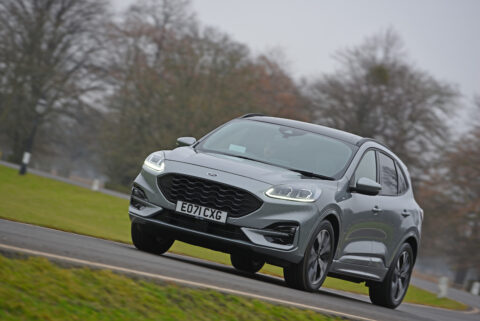
The Ford Kuga may externally mimic the look of a car from one of the world’s most enduringly stylish car companies, but this illusion doesn’t survive entry into the cabin.
Nothing about the monochrome materials or foolproof architecture is immediately disappointing, and the propped-up driving position and supportive ST-Line sports seats of our test car strike a good balance between making you feel connected to the road and sitting high above it.
However, closer acquaintance throws the cheaper interior plastics into sharp relief, and it’s clear some corners have been cut. The upper door cards, for example, are trimmed in soft-touch artificial leather in the front but brittle-feeling plastic in the back, despite sharing the exact same design.
Rivals from Mazda and Peugeot in particular are warmer, more interesting to behold and more pleasant to spend time in.
There are also some interesting plastic textures, such as the brushed finish on the transmission tunnel, and the touch points in our mid-ranking example are of decent quality.
The Kuga does better in terms of occupant comfort and space. Despite the hefty A-pillars, this is an airy cabin, with plenty of leg and head room whichever part of the cabin you’re sitting in.
This is particularly true in the rear, because the bench can slide 150mm fore and aft, although as such you will sacrifice some boot space to maximise leg room.
That boot space is reduced somewhat for the PHEV from the get-go, falling from 645 litres in the regular models to 581 litres with the seats slid fully forward, but the boot floor does at least conveniently sit flush with the broad boot lip.
Storage space elsewhere is good, although not quite up to the cavernous standards of the Skoda Kodiaq. Larger door bins would be helpful, but there is at least plentiful storage for keys, phones and so on.
Ford Kuga multimedia
The Kuga uses Ford‘s Sync3 infotainment software, which will seem faintly futuristic to anybody familiar with the Sync2 software of older models, especially because it’s paired alongside a 12.3in digital instrument display for cars with ST-Line trim and above.
It uses an 8.0in touchscreen that sits proud atop the dashboard (too proud, perhaps), although usefully there’s still some physical switchgear mounted just below, which makes quick adjustments easy.
Among the ranks of non-premium SUVs, the set-up is slick but still not of the best resolution, and neither are the menus as streamlined as we would like.
A rotary controller like the one in the Mazda CX-5 may have helped in this respect, but Apple CarPlay and Android Auto can at least be used through the display. A premium Bang & Olufsen sound system comes with Titanium trim and above.
